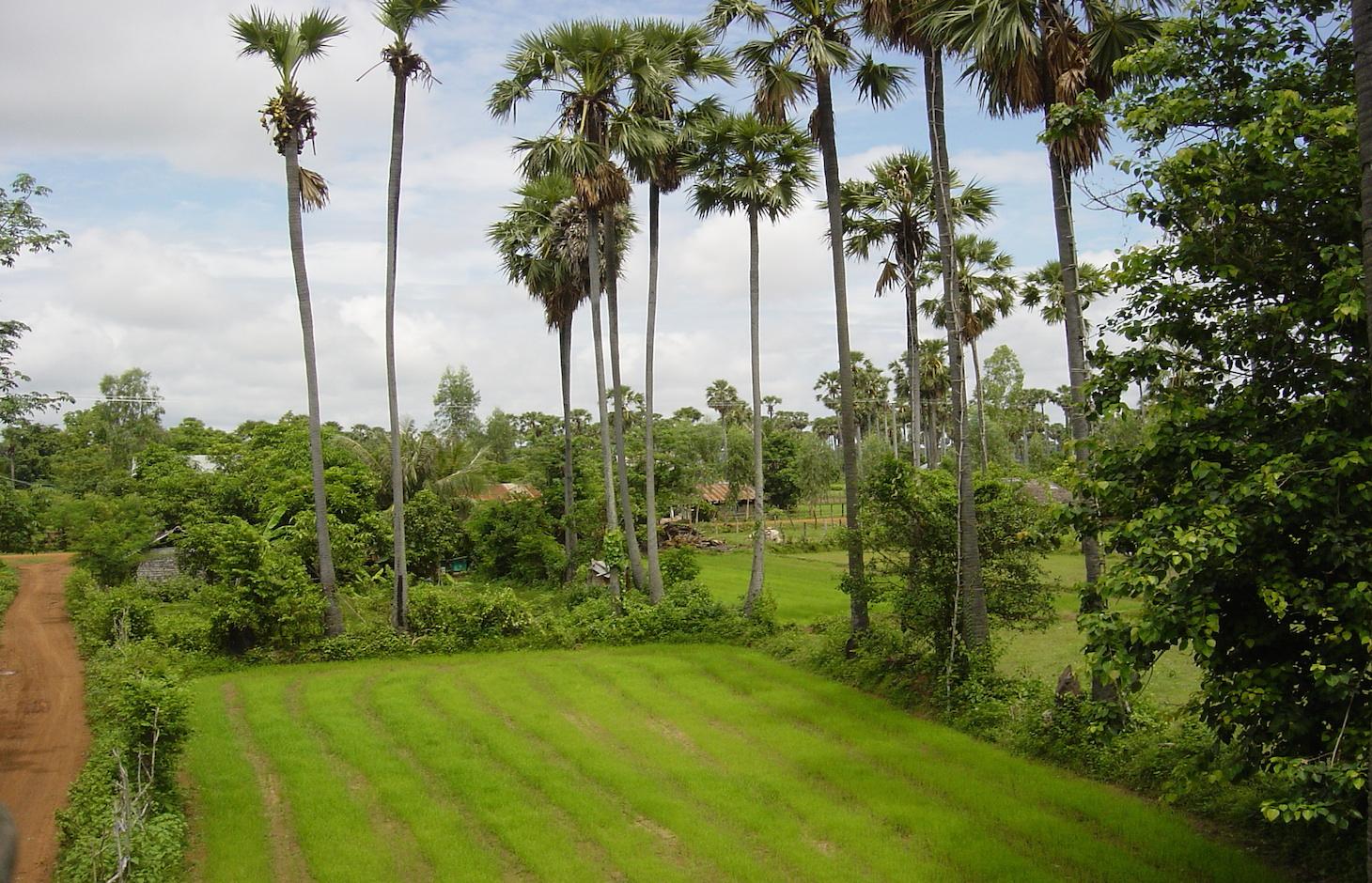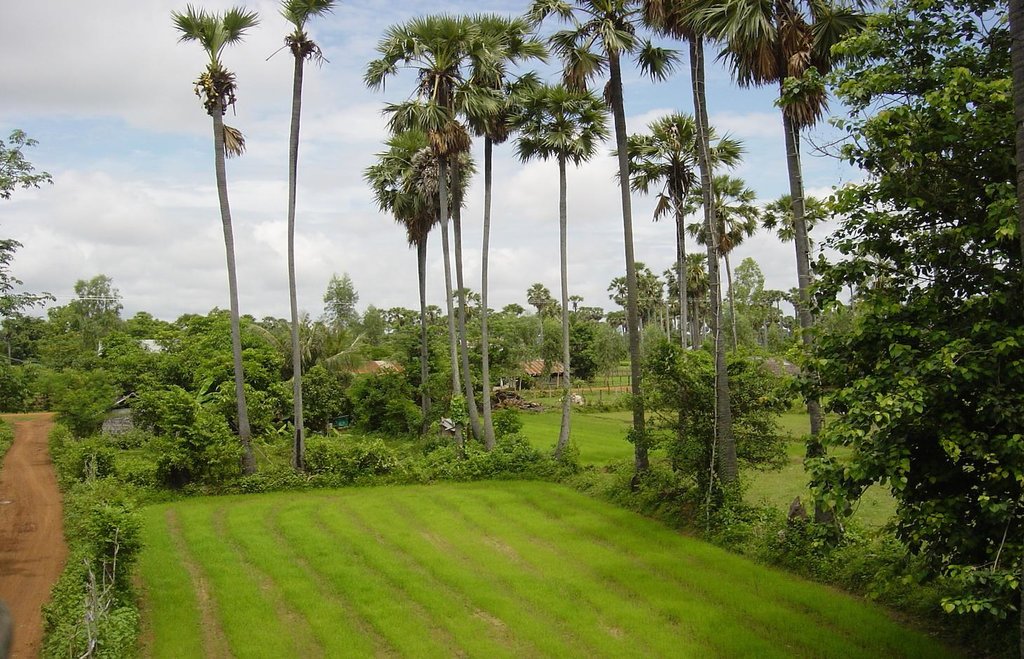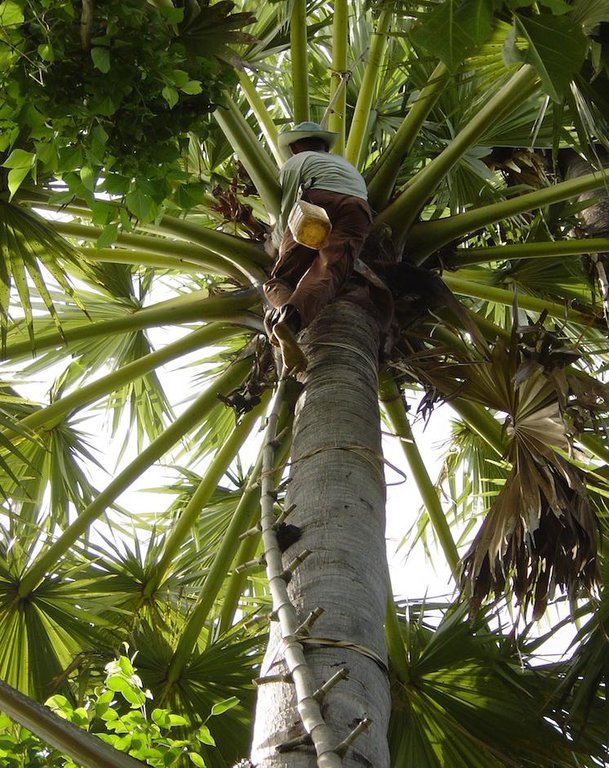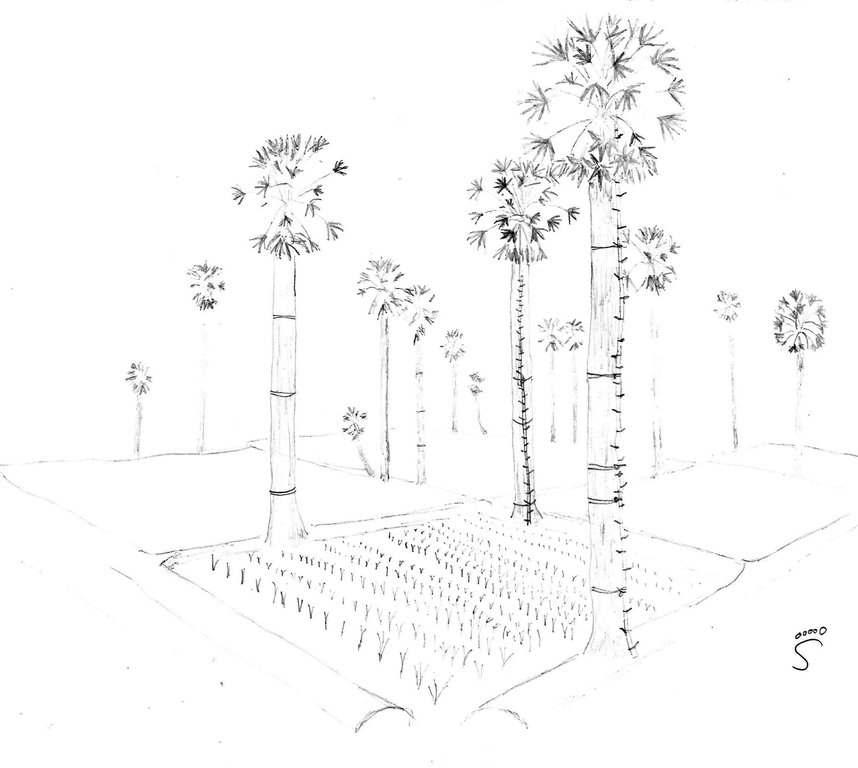Multipurpose use of sugar palm grown on rice field dykes. [Cambodia]
- Creación:
- Actualización:
- Compilador: Stefan Graf
- Editor: –
- Revisor: Deborah Niggli
ការប្រើប្រាស់ដើមតោ្នតដែលដំានៅតាមភ្លឺស្រែ (Khmer)
technologies_1629 - Cambodia
Visualizar secciones
Expandir todo Colapsar todos1. Información general
1.2 Detalles de contacto de las personas de referencia e instituciones involucradas en la evaluación y la documentación de la Tecnología
Especialista MST:
Khun Lean Hak
kleanghak@yahoo.com / sofdec@camintel.com
SOFDEC/LAREC, www.sofdec.com
1.3 Condiciones referidas al uso de datos documentados mediante WOCAT
¿Cuándo se compilaron los datos (en el campo)?
10/07/2014
El compilador y la/s persona(s) de referencia claves aceptan las condiciones acerca del uso de los datos documentados mediante WOCAT:
Sí
1.4 Declaración de la sostenibilidad de la Tecnología descrita
¿La Tecnología aquí descrita resulta problemática en relación a la degradación de la tierra, de tal forma que no puede considerársela una tecnología sostenible para el manejo de la tierra?
No
2. Descripción de la Tecnología MST
2.1 Breve descripción de la Tecnología
Definición de la Tecnología:
Sugar palms growing on the dykes along the rice fields are used as source of income and have different effects on the growing of the rice, like reducing the wind speed and thus the evaporation and wind erosion.
2.2 Descripción detallada de la Tecnología
Descripción:
The sugar palm (Borassus flabellifer ) is the national tree of Cambodia, it is well adapted to the local natural environment and there is a long tradition to grow sugar palms. Therefore, only a negligible workload is required for both the establishment (fruits falling down from the already existing trees will grow) and the maintenance of the trees. As the sugar palm is resistant to waterlogging and floods (even in flooded areas in the floodplains), and it grows well at low pH, it is planted/grown on the rice field dykes and around the houses. The trees which are growing around the paddy fields have some positive effects on both soil and rice, as they slow down the wind and thus reduce evaporation and wind erosion. They also attract wildlife, and thus allow the establishment of other vegetation. The trees also have a purifying effect on the groundwater, and cycle the nutrients which are otherwise lost in the groundwater. The sugar palms and their products can be used in manifold ways: the leaves for wickerwork and roofs; the stems as fences, for ropes and strings; the fruits as food, fodder and to make straw palatable for cattle; the sap as fodder, to make wine, sugar, and vinegar; and the trunk as construction wood – these are only some of its uses. They reduce the risk of a complete crop failure, as their products are not subject to weather fluctuations.
After the collectivization of land during the civil war (1975-1979), the land and the trees were newly distributed to the people according to the size of the household. The ownership of the land and of the trees was not related. Until today, the trees can be growing on someone’s land, but can be sold or rented to somebody else who harvests its products.
The main reason to plant sugar palms in this area is the sap collection. In order to collect the sap, firstly bamboo ladders are tied to the sugar palm trees. In the dry season, the tapper climbs up the trees to collect the sap. The male or female inflorescence is crushed with a special tool and a piece of it sliced off. Bottles are hanged beneath the cut part, and the sap will flow into these bottles. The crushing and slicing is repeated twice a day, so the amount of collected sap can be optimized. Most of the sap is cooked on a fire and made into syrup, and if there is too much sap, it is fermented and sold as palm wine.
The fruits that fall down on the rice fields are thrown on the dykes, where they grow. The seedlings tolerate some cattle grazing, as long as only the leaves and not the bud are eaten.
The analysed area is flat (slope < 2%), with a tropical climate (dry season from November to May and wet season from June to October), and the soils are mostly sandy or loamy. The soil has a low fertility, contains little organic matter, and acidifies. The area has been deforested a long time ago, and the groundwater table is rather high (1-2 m during the dry season, on the surface during wet season). Due to climate change, farmers notice more erratic rainfalls, temperature rises and more recurrent droughts. Rice is the predominant crop grown in the area, since it serves as staple food (mix subsistence and commercial activities).
The increasing migration rate (the young generation leaves the villages to work in the cities, garment industry or abroad) results in a decrease of available labour force in the area which has detrimental effects on the agricultural activities. Furthermore, the civil war in the 1970s (Khmer Rouge) led to the loss of agricultural knowledge which different NGOs try to re-establish.
2.3 Fotografías de la Tecnología
2.5 País/ región/ lugares donde la Tecnología fue aplicada y que se hallan comprendidos por esta evaluación
País:
Cambodia
Región/ Estado/ Provincia:
Kampong Chhnang
Especifique más el lugar :
Rolear Bier / Thnorng Kombot
2.6 Fecha de la implementación
Si no se conoce el año preciso, indique la fecha aproximada:
- hace más de 50 años atrás (tradicional)
2.7 Introducción de la Tecnología
Especifique cómo se introdujo la Tecnología:
- como parte de un sistema tradicional (> 50 años)
Comentarios (tipo de proyecto, etc.):
It is a traditional tree in Cambodia, with historical use. Its introduction on the rice field dykes is unknown.
3. Clasificación de la Tecnología MST
3.1 Propósito(s) principal(es) de la Tecnología MST
- mejorar la producción
- reducir, prevenir, restaurar la degradación de la tierra
3.2 Tipo(s) actuales de uso de la tierra donde se aplica la Tecnología

Tierras cultivadas
- Cosecha anual
- Cosecha de árboles y arbustos
Comentarios:
Major land use problems (compiler’s opinion): Lack of organic matter, lack of water retention in soil, irregularity of rainfall, low soil fertility (sandy soil), monocultures, bare soil during dry season, ploughing, wind erosion and dust storms.
Major land use problems (land users’ perception): Soil fertility is low, rainfall is not secured in the beginning of the rainy season.
3.3 Información adicional sobre el uso de tierras
Provisión de agua para la tierra donde se aplica la Tecnología:
- de secano
Número de temporadas de cultivo por año:
- 1
Especifique:
Longest growing period in days: 210, Longest growing period from month to month: June-December
3.4 Grupo MST al que pertenece la Tecnología
- agroforestería
- rompevientos/ cinturones de protección
3.5 Difusión de la Tecnología
Especifique la difusión de la Tecnología:
- distribuida parejamente sobre un área
Si la tecnología se halla difundida homogéneamente en un área, indique el área aproximada que cubre:
- 10-100 km2
Comentarios:
This technology is applied in most parts of Cambodia. Almost everywhere there are some sugar palms growing along the rice fields, but not in this density. The area mentioned is the area in the district where the technology is applied.
3.6 Medidas MST que componen la Tecnología

medidas vegetativas
- V1: Cubierta de árboles y arbustos
Comentarios:
Type of vegetative measures: aligned: -along boundary
3.7 Principales tipos de degradación de la tierra encarados con la Tecnología

erosión de suelos por viento
- Et: pérdida de capa arable

deterioro químico del suelo
- Cn: reducción de la fertilidad y contenido reducido de la materia orgánica del suelo (no ocasionados por la erosión)

degradación biológica
- Bh: pérdida de hábitats
- Bs: reducción en la calidad y composición/ diversidad de las especies
Comentarios:
Main causes of degradation: soil management (Ploughing of the soil. Depending on the rainfall, sometimes the land is left bare for several days or weeks.), crop management (annual, perennial, tree/shrub) (Mainly rice is grown in monocultures.), over-exploitation of vegetation for domestic use (Straw is usually removed from the fields.), labour availability (Labour availability is low due to high migration rates (garment industry, drift to the cities, working abroad).)
Secondary causes of degradation: change in temperature (More hot days, the soil dries out faster.), droughts, education, access to knowledge and support services (Little knowledge about soil conservation.), war and conflicts (During the Khmer Rouge regime, a lot of agricultural knowledge got lost.)
3.8 Prevención, reducción o restauración de la degradación de la tierra
Especifique la meta de la Tecnología con relación a la degradación de la tierra:
- prevenir la degradación de la tierra
4. Especificaciones técnicas, actividades de implementación, insumos y costos
4.1 Dibujo técnico de la Tecnología
4.2 Especificaciones técnicas/ explicaciones del dibujo técnico
Sugar palms (Borassus flabellifer) with bamboo ladders growing on the dikes around the rice fields.
Kampong Chhnang
Date: 2014
Technical knowledge required for field staff / advisors: low
Technical knowledge required for land users: low (They grow almost by themselves, as the fallen fruits are just thrown on the dykes as only management.)
Main technical functions: reduction in wind speed
Secondary technical functions: increase in nutrient availability (supply, recycling,…), increase / maintain water stored in soil
Aligned: -along boundary
Vegetative material: F : fruit trees / shrubs
Number of plants per (ha): 63
Vertical interval between rows / strips / blocks (m): 20
Vertical interval within rows / strips / blocks (m): 10
Fruit trees / shrubs species: Mostly naturally regenerated, but seeds are thrown on the dykes when they fall into the rice fields.
4.3 Información general sobre el cálculo de insumos y costos
Indique el costo promedio del salario de trabajo contratado por día:
5.00
4.4 Actividades de establecimiento
| Actividad | Tipo de medida | Momento | |
|---|---|---|---|
| 1. | Build a stove and buy pans to cook the sap into sugar. | Vegetativas |
4.5 Costos e insumos necesarios para el establecimiento
| Especifique insumo | Unidad | Cantidad | Costos por unidad | Costos totales por insumo | % de los costos cubiertos por los usuarios de las tierras | |
|---|---|---|---|---|---|---|
| Mano de obra | Labour | ha | 1,0 | 10,0 | 10,0 | 100,0 |
| Equipo | machine use | ha | 1,0 | 25,0 | 25,0 | 100,0 |
| Costos totales para establecer la Tecnología | 35,0 | |||||
4.6 Actividades de establecimiento/ recurrentes
| Actividad | Tipo de medida | Momento/ frequencia | |
|---|---|---|---|
| 1. | Tie the bamboo ladders to the tree | Vegetativas | |
| 2. | Collect the sap by pressing the inflorescence, cutting a slice off and putting a bottle underneath. | Vegetativas | December-April, twice a day |
| 3. | Cook the sap to make sugar | Vegetativas | Once or twice a day |
| 4. | Ferment the juice to make palm wine | Vegetativas | If there's too much juice. |
4.7 Costos e insumos necesarios para actividades de mantenimiento/ recurrentes (por año)
| Especifique insumo | Unidad | Cantidad | Costos por unidad | Costos totales por insumo | % de los costos cubiertos por los usuarios de las tierras | |
|---|---|---|---|---|---|---|
| Mano de obra | Labour | ha | 1,0 | 3221,0 | 3221,0 | 100,0 |
| Material de construcción | Firewood | ha | 1,0 | 357,0 | 357,0 | 100,0 |
| Material de construcción | Bamboo and rattan | ha | 1,0 | 471,0 | 471,0 | 100,0 |
| Indique los costos totales para mantenecer la Tecnología | 4049,0 | |||||
Comentarios:
Machinery/ tools: Self-made crusher to induce a higher sap flow.
The costs were calculated with 44 trees (one unit), transformed into 62 trees per ha. The assessed farmer owns 0.35 ha of rice fields, with 22 trees on the dykes, but he bought additional trees on nearby dykes. The whole family is involved in the process.
The maintenance costs indicated above are that high because labour was calculated for each step. However, a big part of the work is done voluntarly by local land users and are not payed.
4.8 Factores más determinantes que afectan los costos:
Describa los factores más determinantes que afectan los costos:
The factors affecting the costs are mainly the inputs (firewood, work to cook the sap to sugar) used to transform the sap into saleable products. They are not necessary to benefit from the positive effects of sugar palms on the microclimate and soil. To implement sugar palms on the rice field dikes the costs are negligible.
5. Entorno natural y humano
5.1 Clima
Lluvia anual
- < 250 mm
- 251-500 mm
- 501-750 mm
- 751-1,000 mm
- 1,001-1,500 mm
- 1,501-2,000 mm
- 2,001-3,000 mm
- 3,001-4,000 mm
- > 4,000 mm
Especificaciones/ comentarios sobre la cantidad de lluvia:
1486.45 mm 2013 in Kampong Chhnang
Zona agroclimática
- Sub-húmeda
Thermal climate class: tropics. 27-35°C
5.2 Topografía
Pendientes en promedio:
- plana (0-2 %)
- ligera (3-5%)
- moderada (6-10%)
- ondulada (11-15%)
- accidentada (16-30%)
- empinada (31-60%)
- muy empinada (>60%)
Formaciones telúricas:
- meseta/ planicies
- cordilleras
- laderas montañosas
- laderas de cerro
- pies de monte
- fondo del valle
Zona altitudinal:
- 0-100 m s.n.m.
- 101-500 m s.n.m.
- 501-1,000 m s.n.m
- 1,001-1,500 m s.n.m
- 1,501-2,000 m s.n.m
- 2,001-2,500 m s.n.m
- 2,501-3,000 m s.n.m
- 3,001-4,000 m s.n.m
- > 4,000 m s.n.m
5.3 Suelos
Profundidad promedio del suelo:
- muy superficial (0-20 cm)
- superficial (21-50 cm)
- moderadamente profunda (51-80 cm)
- profunda (81-120 cm)
- muy profunda (>120 cm)
Textura del suelo (capa arable):
- áspera/ ligera (arenosa)
- mediana (limosa)
Materia orgánica de capa arable:
- media (1-3%)
- baja (<1%)
5.4 Disponibilidad y calidad de agua
Agua subterránea:
< 5 m
Disponibilidad de aguas superficiales:
pobre/ ninguna
Calidad de agua (sin tratar):
agua potable de mala calidad (requiere tratamiento)
Comentarios y especificaciones adicionales sobre calidad y cantidad de agua:
Ground water table: during dry season
Availability of surface water: during dry season
Drinking water: People use it for drinking after filtering or boiling.
5.5 Biodiversidad
Diversidad de especies:
- mediana
5.6 Las características de los usuarios de la tierra que aplican la Tecnología
Orientación del mercado del sistema de producción:
- mixta (subsistencia/ comercial)
Ingresos no agrarios:
- 10-50% de todo el ingreso
Nivel relativo de riqueza:
- pobre
- promedio
Individuos o grupos:
- individual/ doméstico
Nivel de mecanización:
- trabajo manual
Género:
- mujeres
- hombres
Indique otras características relevantes de los usuarios de las tierras:
Land users applying the Technology are mainly common / average land users
Population density: 50-100 persons/km2
Annual population growth: 0.5% - 1%
Off-farm income specification: Handicraft, remittances, and factory work.
5.7 Área promedio de la tierra que pertenece a o es arrendada por usuarios de tierra que aplican la Tecnología
- < 0.5 ha
- 0.5-1 ha
- 1-2 ha
- 2-5 ha
- 5-15 ha
- 15-50 ha
- 50-100 ha
- 100-500 ha
- 500-1,000 ha
- 1,000-10,000 ha
- > 10,000 ha
¿Esto se considera de pequeña, mediana o gran escala (refiriéndose al contexto local)?
- pequeña escala
5.8 Tenencia de tierra, uso de tierra y derechos de uso de agua
Tenencia de tierra:
- comunitaria/ aldea
- individual, sin título
Derechos de uso de tierra:
- comunitarios (organizado)
- individual
Derechos de uso de agua:
- acceso abierto (no organizado)
Comentarios:
Land users have a title that is not recognized by the state. The trees sold by farmers to neighbours have a paper signed by the village chief to certify the ownership.
5.9 Acceso a servicios e infraestructura
salud:
- pobre
- moderado
- bueno
educación:
- pobre
- moderado
- bueno
asistencia técnica:
- pobre
- moderado
- bueno
empleo (ej. fuera de la granja):
- pobre
- moderado
- bueno
mercados:
- pobre
- moderado
- bueno
energía:
- pobre
- moderado
- bueno
caminos y transporte:
- pobre
- moderado
- bueno
agua potable y saneamiento:
- pobre
- moderado
- bueno
servicios financieros:
- pobre
- moderado
- bueno
6. Impactos y comentarios para concluir
6.1 Impactos in situ demostrados por la Tecnología
Impactos socioeconómicos
Producción
producción de cultivo
Comentarios/ especifique:
Leaves fall on the fields, but if they are removed the adverse effect is negligible.
producción de madera
Comentarios/ especifique:
Old trees are logged and used as firewood or construction material.
riesgo de fracaso de producción
Comentarios/ especifique:
Sugar palms can grow in adverse conditions.
manejo de tierras
Comentarios/ especifique:
Trees on the dykes might hinder the use of machines on the fields.
Disponibilidad y calidad de agua
disponibilidad de agua potable
Comentarios/ especifique:
Trees have a purifying effect on the water.
Ingreso y costos
ingreso agrario
Comentarios/ especifique:
The products of the sugar palms are sold on the market, whereas rice is only grown for sustenance.
diversidad de fuentes de ingreso
Comentarios/ especifique:
The products of the sugar palms are sold on the market, whereas rice is only grown for sustenance.
carga de trabajo
Comentarios/ especifique:
Harvesting and processing of sap is strenuous and time consuming, especially during dry season.
Impactos socioculturales
situación de salud
Comentarios/ especifique:
Cheap alcohol, diabetes
oportunidades culturales
Comentarios/ especifique:
Aesthetic value.
contribution to human well-being
Comentarios/ especifique:
The products of the sugar palms generate income to the land user and his family (rice is only used for home consumption), and they are more resilient to erratic rainfall patterns.
Impactos ecológicos
Ciclo de agua/ escurrimiento de sedimento
nivel freático/ acuífero
Comentarios/ especifique:
The roots reach the ground water table, and have a difficult to quantify effect on it.
evaporación
Comentarios/ especifique:
Evaporation is tackled due to the decrease of wind speed.
Suelo
humedad del suelo
Comentarios/ especifique:
Evaporation is tackled due to the decrease of wind speed.
ciclo/ recarga de nutrientes
Comentarios/ especifique:
Nutrients below the root level of annuals are picked up and reintroduced in the nutrient cycle.
Biodiversidad: vegetación, animales
biomasa/ sobre suelo C
diversidad vegetal
Comentarios/ especifique:
The region is prone to monocultures (rice), however in this region there are a lot of sugar palms and other tree species. Sugar palms protect the other plants, attract birds (dissemination of seeds) and have therefore a positive impact on biodiversity.
diversidad animal
Comentarios/ especifique:
Sugar palms as habitat for different animals (bats, birds, etc.)
especies benéficas
diversidad de hábitats
Reducción de riesgos de desastres y riesgos climáticos
velocidad de viento
6.2 Impactos fuera del sitio demostrados por la Tecnología
contaminación de aguas subterráneas/ de ríos
Comentarios/ especifique:
Purifying effects of trees.
sedimentos transportados por el viento
Comentarios/ especifique:
Reduction of wind velocity.
Deforestation
Comentarios/ especifique:
Firewood is used as the main source of energy. The land user buys the wood.
6.3 Exposición y sensibilidad de la Tecnología al cambio climático gradual y a extremos relacionados al clima/ desastres (desde la percepción de los usuarios de tierras)
Cambio climático gradual
Cambio climático gradual
| Estación | tipo de cambios climáticos/ climas extremos | ¿Cómo es que la tecnología soporta esto? | |
|---|---|---|---|
| temperatura anual | incrementó | bien |
Extremos (desastres) relacionados al clima
Desastres climatológicos:
| ¿Cómo es que la tecnología soporta esto? | |
|---|---|
| tormenta de lluvia local | bien |
| tormenta de viento | bien |
Desastres climatológicos
| ¿Cómo es que la tecnología soporta esto? | |
|---|---|
| sequía | bien |
Desastres hidrológicos
| ¿Cómo es que la tecnología soporta esto? | |
|---|---|
| inundación general (río) | bien |
Otras consecuencias relacionadas al clima
Otras consecuencias relacionadas al clima
| ¿Cómo es que la tecnología soporta esto? | |
|---|---|
| periodo reducido de crecimiento | no muy bien |
6.4 Análisis costo-beneficio
¿Cómo se comparan los beneficios con los costos de mantenimiento/ recurrentes (desde la perspectiva de los usuarios de tierra)?
Ingresos a largo plazo:
ligeramente positivo
Comentarios:
Since it is a traditional technology, the initial costs cannot be estimated.
6.5 Adopción de la Tecnología
- más de 50%
Si tiene la información disponible, cuantifique (número de hogares y/o área cubierta):
100% or 7 land user families
De todos quienes adoptaron la Tecnología, ¿cuántos lo hicieron espontáneamente, es decir, sin recibir incentivos/ pagos materiales?
- 90-100%
Comentarios:
The growing of sugar palms and its use for economic activities is a traditional technology.
100% of land user families have adopted the Technology without any external material support
7 land user families have adopted the Technology without any external material support
7 farmers produce sugar, however sugar palms are widely spread in this area. This is the reason why estimations are difficult to make.
6.7 Fuerzas/ ventajas/ oportunidades de la Tecnología
| Fuerzas/ ventajas/ oportunidades desde la perspectiva del usuario de la tierra |
|---|
| Many different uses of sugar palms, both for selling on the market and for home consumption (leaves, construction wood, fibre, sugar, wine, fruits, and vinegar). |
| Sugar palms protect the rice from the wind. |
| Fuerzas/ ventajas/ oportunidades desde la perspectiva del compilador o de otra persona de referencia clave |
|---|
| They slow down the wind, thus reduce evaporation, crop destruction and wind erosion. |
| Sugar palms are tolerant plants growing in adverse conditions like water logging, floods and droughts; they don’t need any care like fertilizer or pesticides. They produce anyway their useful products (Sap, leaves, stems) which can be transformed in many different ways (Sugar, wine, vinegar, house coverings, handicraft…) |
6.8 Debilidades/ desventajas/ riesgos de la Tecnología y formas de sobreponerse a ellos
| Debilidades/ desventajas/ riesgos desde la perspectiva del usuario de la tierra | ¿Cómo sobreponerse a ellas? |
|---|---|
| Fallen palm leaves can hinder the rice growth on the fields. | Check the fields regularly and remove the fallen leaves. |
| Old trees can fall in storms and destroy a part of the crop. | Remove the oldest trees. |
| Debilidades/ desventajas/ riesgos desde la perspectiva del compilador o de otra persona de referencia clave | ¿Cómo sobreponerse a ellas? |
|---|---|
| Collecting sap is dangerous, especially when there is wind. | Use safety devices. |
| To make sugar, firewood is used, which induces deforestation. | As energy is needed in the dry season, solar energy could be used to boil the sap, with parabolic mirror cookers for example. |
| Plants producing a lot of sap are tapped more, thus produce no fruit, so no offspring. Only plants producing less sap will reproduce. | Select good producing trees and plant the selected seeds. |
| Because of the trees, mechanized farm operations on the rice fields are hindered. | Plant the trees in rows perpendicular to main wind, or long curved rice fields. |
| Only syrup can be made on farm, which is sold at a low price. | Organize in cooperatives to make sugar, which could get a better price. |
7. Referencias y vínculos
7.1 Métodos/ fuentes de información
- visitas de campo, encuestas de campo
- entrevistas con usuarios de tierras
7.2 Vínculos a las publicaciones disponibles
Título, autor, año, ISBN:
Borin, K. 1998. Sugar Palm (Borassus flabellifer): Potential feed source for livestock in small-scale farming systems. WAR 91
¿Dónde se halla disponible? ¿Costo?
http://www.fao.org/docrep/w9980t/w9980T04.htm#TopOfPage (free)
Título, autor, año, ISBN:
Feedipedia Sugar Palm (Borassus flabellifer)
¿Dónde se halla disponible? ¿Costo?
http://www.feedipedia.org/node/178
Título, autor, año, ISBN:
Johnson, D.V. 2010. Tropical Palms. FAO.
¿Dónde se halla disponible? ¿Costo?
http://www.fao.org/docrep/012/i1590e/i1590e.pdf
Vínculos y módulos
Expandir todo Colapsar todosVínculos
No hay vínculos
Módulos
No se hallaron módulos





